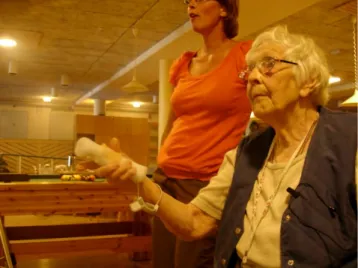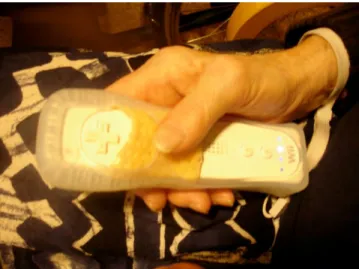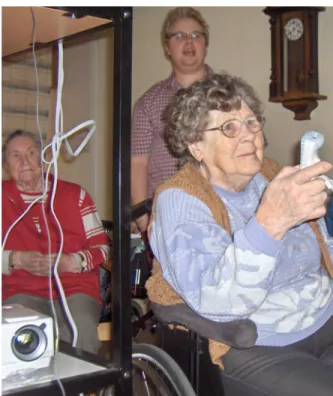Fun and Joy of movement – powerful
ingredient in rehabilitation
Abstract
In this position paper we discuss and problematize the experience of conducting a participative design project aiming at supporting people with dementia living in a special housing with fun and physically engaging rehabilitation activities.
Keywords
Design methods, physical activity, joy of motion, well-being
ACM Classification Keywords
J.3 LIFE AND MEDICAL SCIENCES
General Terms
Human Factors, design
Introduction
With the lyrics from Phyllis Molinary, and music from composer Artie Butler, the jazz singer Shirley Horn recorded “Here’s to life” in 1990:
As long as I am still in the game I want to play, for laughs, for life, for love
Are we as human beings that different from childhood to old age when it comes to the positive effects of being Copyright is held by the author/owner(s).
Helena Tobiasson
Physiotherapist and PhD student at Kungliga Tekniska Högskolan 100 44 Stockholm
Sweden tobi@csc.kth.se
physically active, play and have fun? In pedagogy the importance of play and joy of movement are well established and we keep arguing with our kids to take action and be physically alert to enhance learning and self-esteem [7,9]. Within healthcare and preventive healthcare research results points towards the benefits of being physically active [3,5,6]. How is this addressed at the Swedish elderly-care domain? What seem to be offered at many places are sedately and calm activities such as bingo, sitting gymnastics, song, film,
storytelling etc. To draw the line between what is healthcare and what are social/leisure activities can be tricky. People living at special housing need healthcare but also support for living a life and not only being alive. How can we design opportunities to be physically engaged for old people living their lives at Special Housing? For the purpose of rehabilitation, entertainment and joy of movement.
Motion-controlled games at hand
During 2009 and 2010 we did a participatory-design oriented research project introducing the Nintendo Wii at three elderly care units in different places in Sweden. Two of the three places were locked department for old people suffering from dementia. One of the two places was run under the municipality the other was a private initiative. The third place was a day-rehabilitation facility run by another municipality. There were 17 active “old gamers” and around the same numbers of care-givers, relatives and friends that joined the game sessions. The project is described more details in [10]. The collected empirical data from the sites were video-recordings, photos, interviews, participative
observations and design workshops. When doing a content analysis of the data, four categories came through. The categories were:
Managing the console
questions and comments about where to press and when, or how it was smoothly redesigned to ease but not take away the challenge.
Managing the system
the structure and information given in the different games, setting up and operating the system, and the motivation and immersion in the game.
Physical movements
This category includes comments about fatigue, range of motion, coordination, balance, joy of movement, modification and redesign of movements are mentioned.
Chatting and social expressions
success and failure during play, cheering, teasing, competition – the social interaction between gamers, their caregivers and others participating in the game.
Fun at focus
When revisiting the material we want to focus on some of the results from our studies, that points towards, fun and physical activity as being important ingredients in motivation for engagement. By fun used in this context we refer to the use of that word by the old gamers and others, when sharing the experience of playing the Nintendo Wii. It seems as fun come as an expression when movement is mixed with physical and cognitive challenge. When something is at stake or you need to compete and the outcome of that leisure competition is not clear. From observations we can underline that expressions with the smile and laughter we noticed on the old gamers not only related to success. We could often see smiles even when failing to score. We could see the movement pattern turn from stiff and minor to stiff and major and repetitive in the eagerness to score
and manage the game. In comparison with the current practice of seated gymnastics that may be explained as similar to testing functionality on a car but never driving or going somewhere. You sit and imagine picking apples or just stretching your arms, you sit-walk on the same spot, you turn sidewise etc. It is somewhat a test of your physical ability but real action, real hands-on activities are less often provided. Not to underestimate the difficulties to provide such
environment for individuals that can differ in physical abilities from day to day. But from our experiences we are surprised of how much “power” and “energy” these old bodies still contains.
This is some of the design implications and the results from our studies of Wii in action at elderly centers:
§ Joy to compete
§ Something is at stake
§ Positive stress – in failure or success in the game
§ Fun to learn something new
“it is great to see how they get excited about learning and trying something new. For them it is all about to try to preserve skills such as get dressed, eat and use the bathroom” Caregiver
“this is a common thing - kids play it - it is not something specific for old people, everyone is playing”
Staff-Manager
Why motion-controlled games?
Why did motion-controlled games such as the Nintendo Wii, Kinect and Eye-toy among others make its way into elderly-care units? For some years now media and research has reported on the phenomena [2,11]. Part
of the answer to why action-games made its way into elderly-care we argue is, that it provides an equal arena for engaging action to take part. The technology managed to even up, overlap and bridge between two players having very different physical abilities. Enough to make it a match! This has often been very tricky within physical rehabilitation or habilitation.
Figure 1 something is at stake here and now
One reflection in retrospect that we would like to point out is that we used off-the shelf technology. Only did we do minor adjustments and the approach and acceptance from all participants to alternative mode of motion was very broad. This is somewhat remarkable since many systems and product used within the domain has been designed and labeled to be aid-appliances. Not always that fun and visually attractive.
Figure 2. “Assistive technology” supporting joy of movement Many practitioners in rehabilitation and other
healthcare professionals have experienced the difficulties in the problematic situations of motivating individuals, may it be old or young, to perform training programs [4]. We would very much like to encourage further research and development into fun as a tool within elderly-care and other domains in healthcare. This does exist and as an example there is “The International Society for Humor Studies” to be found at http://www.humorresearch.org. At hospital department hosting children you will often find a clown for the purpose of comfort and joy. When investigating notions such as joy of motion it seems as it is more frequently used to describe the situation for young people. How the young could benefit from the environment being structured to enhance joy of movement. Growing up and growing old what happen with the joy of movement? Too often the technology-oriented development-projects and systems for elderly put
heavy focus on monitoring and assisting in assessments, as in smart/intelligent homes, fall prevention, safety alarms etc. That is well motivated but there is also a great potential is developing
applications with focus on joy of movement to promote wellbeing and recovering [1]. Now we see initiatives such as “Serious Games” and “Games for Health” [8]. One can only hope the notion of fun will be kept at focus since the simple act of fun seems to be key for motivation and a big portion of well-being. Fun can function as a coping strategy to deal with difficult and depressing situations. It can function as a stress-relief and way to relax. It also seems to provide a respite from experience not easy to endure such as pain and loss of physical or cognitive function. To share a moment of laughter may create a sense of belonging and fellowship. Our observations of other activities such as the sitting gymnastics did not seem to motivate them to perform such a great range of motion as did the Nintendo Wii Sports system, were they, eager to score and beat their fellow gamers, did their uttermost. This at the same time provided practice of balance, their physical ability was used for a purpose and not only to test and preserve function.
”This was fun- just like a kid again playing marbles” ”The winner instinct is still present despite that I am over 90 years old”
”Of course I am in to win”
A trend or a change towards sustainability?
Touch-technology, sensor technology for monitoring of physical parameters and interaction design
incorporating more or less the entire body being very trendy and hyped one can wonder if it will pass when all the different interaction modalities are tested or if this bodily focus is a reaction of us being at our butts for too long? The discussion on sustainability may benefit from incorporating our physical ability as a resource for the fun of motion. As being a former practitioner I reflect on the years when I worked as a physiotherapist in different settings with children, young, grown-ups and old people. The argument for physical activity was that it is of great value for your health. I reflect on all the situations were I failed to motivate individuals to perform with this kind of arguments. It might have worked better if we just let go and played around for the fun of moving at whatever level of physical ability at hand? As I have seen happen with the Nintendo Wii with the old people. Design approaches for bridging the gap between different levels of physical abilities being rather creative it might be of value to reflect on and bridging the gap of mental conceptual kind? Who get to move and play around, when and for what purpose? The gap seem to grow as we get older to how often we are encouraged to try out different movements and to what extent movements are culturally accepted. Let us try to mind that gap!
Figure 3. Where the action is or time flies while having fun.
“It’s a good feeling to feel that you’ve used your body/done something physical. There’s also some physical training in that” Gamer
Acknowledgements
We thank all old players, their relatives and caretakers for letting us play around. We learnt a lot and are happy that you wanted to continue the game. The project were partly funded by the EU-project MonAMI for that we are grateful.
References
[1] Adamle, K N., & Ludwick, R. (2005). Humor in Hospice care: Who, where, and how much? American Journal of Hospice & Palliative Medicine, 22, 287-290 [2] Broeren J, Claesson L, Goude D, Rydmark M, Sunnerhagen KS. Virtual rehabilitation in an activity centre for community-dwelling persons with stroke. The possibilities of 3-dimensional computer games.
Cerebrovasc Dis 2008; 26: 289–296
[3] Cotman, C. W., Berchtold, N. C. Exercise: a
behavioral intervention to enhance brain health and plasticity Trends in Neurosciences Volume 25, Issue 6,
1 June 2002, Pages 295-301
[4] Dacey, M., & Newcomer, R. (2005). A client-centered counseling approach to motivating older adults towards physical activity. Topics in Geriatric Rehabilitation. 21(3), 195-204.
[5] Fysisk aktivitet - Kunskapsunderlag för Folkhälsopolitisk rapport 2010 STATENS
FOLKHÄLSOINSTITUT, ÖSTERSUND 2011, R 2011:15 ISSN 1651-8624 ISBN 978-91-7257-831-9
[6] FYSS 2008 : fysisk aktivitet i sjukdomsprevention och sjukdomsbehandling Stockholm : Statens
folkhälsoinstitut, 2008 - 613 s. ISBN:978-91-7257-543-1 LIBRIS-ID:10734161
[7] Marja-Leena Juntunen and Leena Hyvönen (2004). Embodiment in musical knowing: how body movement facilitates learning within Dalcroze Eurhythmics. British Journal of Music Education, 21, pp 199-214
doi:10.1017/S0265051704005686
[8] Ritterfeld, U., Cody, M. Vorderer, P. (Eds.) (2009)
Serious Games Mechanisms and Effects. New York:
Routledge.
[9] Tinning R.,(2009) “Pedagogy and
Human Movement - Theory, Practice, Research” in “Physical Education and Youth Sport” Series Eds. Bailey R., – 254 pages Routledge
[10] Tobiasson H. There’s More to Movement than Meets the Eye :perspectives on Physical Interaction. [Thesis]. Stockholm: KTH; 2010. Trita-CSC-A, 2010:17.
[11] www.telegraph.co.uk/news/uknews/1563076/Elderl y-addicted-to-Nintendo-Wii-at-care-home.html


